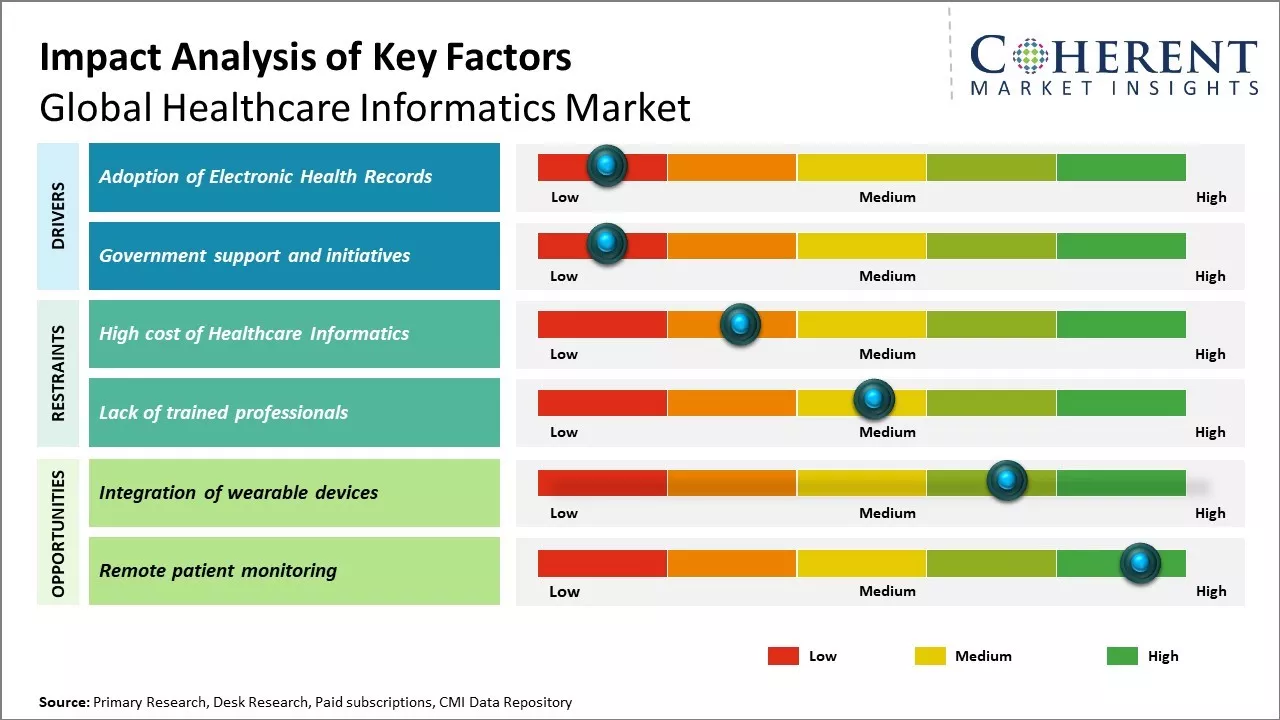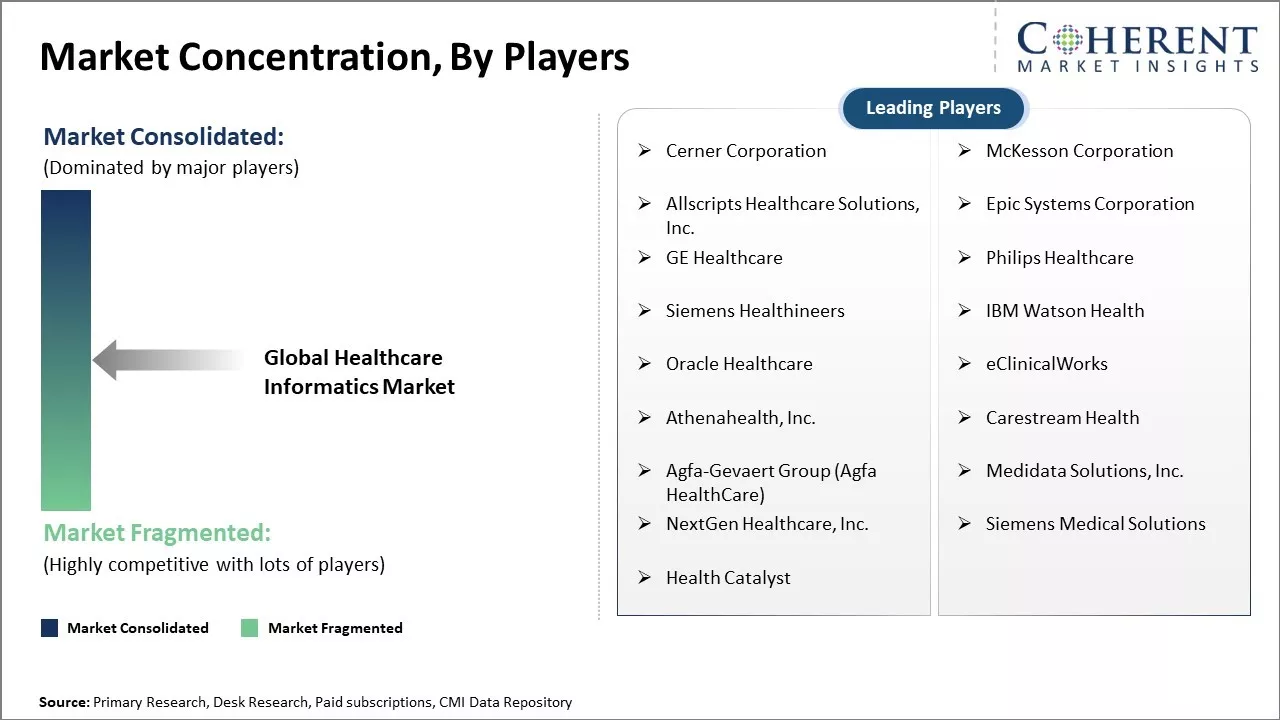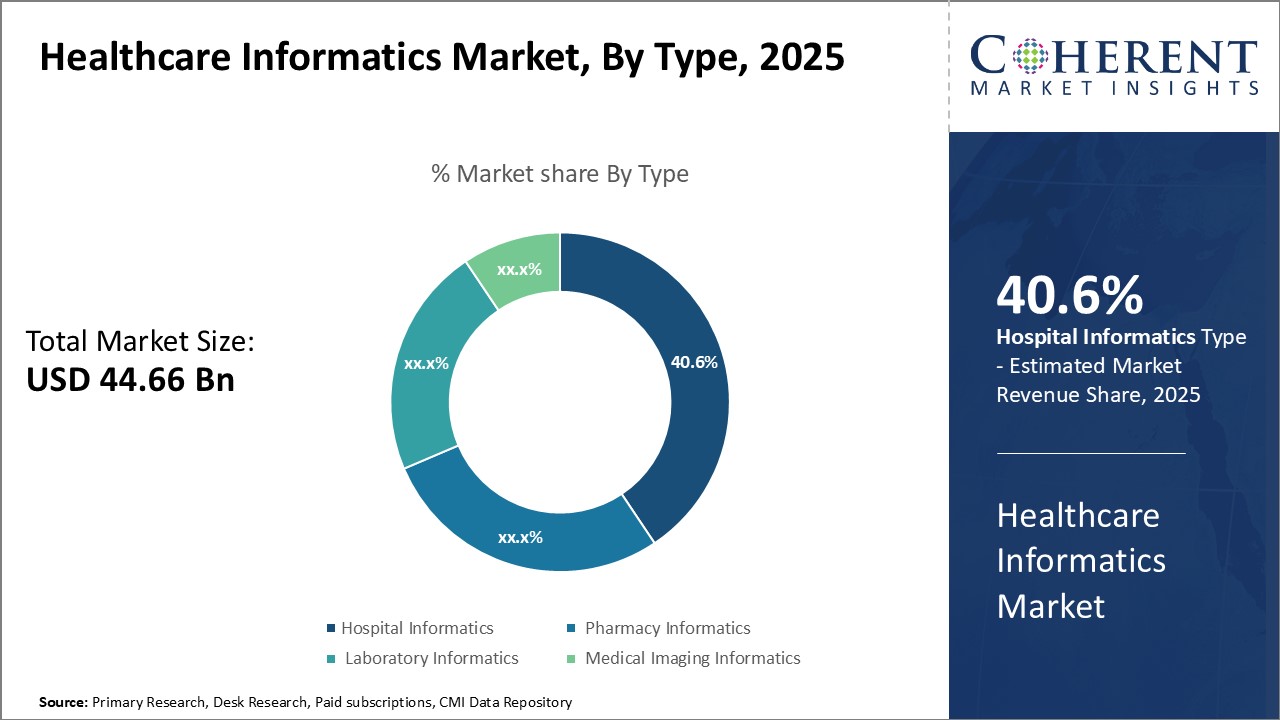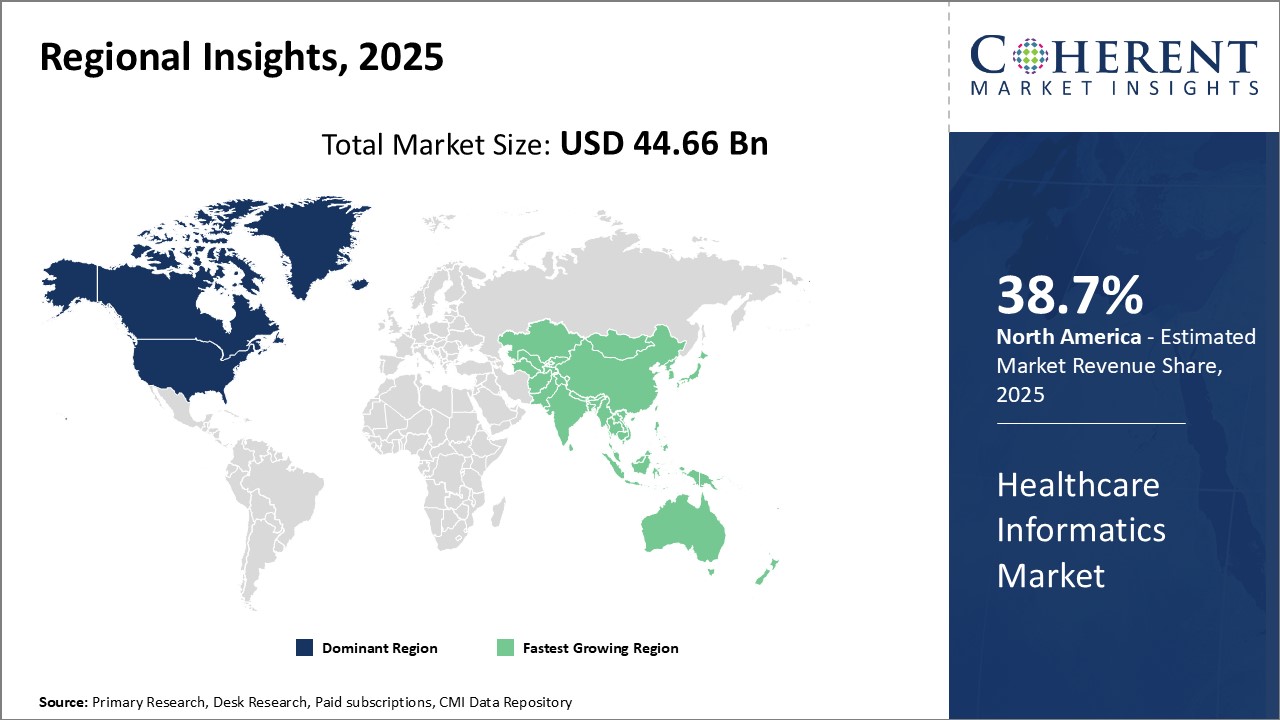Healthcare Informatics Market Size and Trends
Global healthcare informatics market is estimated to be valued at USD 44.66 Bn in 2025 and is expected to reach USD 104.47 Bn by 2032, exhibiting a compound annual growth rate (CAGR) of 12.9% from 2025 to 2032.

Discover market dynamics shaping the industry: Download Free Sample
Global healthcare informatics market growth is driven by factors such as increasing digitalization in the healthcare sector, growing adoption of cloud-based storage solutions and rising need to curtail healthcare costs. Several market players are investing extensively in R&D to develop enhanced healthcare informatics solutions integrated with latest technologies such as AI and machine learning. Adoption of such advanced informatics solutions helps providers in automating procedures, improving patient outcomes and streamlining clinical workflows. However, high deployment cost and privacy & security concerns related to patient data can hamper the market growth.
Adoption of Electronic Health Records
The healthcare industry has witnessed a massive shift towards digitization over the past decade. Previously, patient records were predominantly maintained as physical paperwork, which made storage and sharing of information difficult. This led to various inefficiencies and errors. However, with increasing usage of electronic health records (EHR), most healthcare providers have now transitioned to digital platforms. EHRs allow streamlined management of comprehensive patient health histories and treatment plans. Right from scheduling appointments to recording vitals, prescribing medications, ordering tests and tracking results - everything can be done electronically through a centralized system. This not only improves organizational workflow but also enhances the quality of care delivered. Doctors can instantly access complete medical histories from anywhere, thus, helping them to make faster and more informed clinical decisions. Several regulatory bodies also incentivized the implementation of EHRs through monetary incentives and penalties, thus, boosting adoption rates. For patients, EHRs translate to a more efficient experience. These no longer have to repeatedly fill out forms or transport medical records between different facilities. Digitally stored health records are immediately accessible to authorized providers, removing logistic hassles. In emergencies, crucial health details are right at hand without any delay. Over time, patients have also come to appreciate the personalized care enabled through consolidated health profiles on EHR platforms. For instance, India's National Health Authority launched a Digital Health Incentive Scheme aimed at boosting adoption of digital health records. Healthcare providers, diagnostic centers, and digital solution providers like HMIS and LMIS are eligible for incentives based on the number of digital health records created and linked to the Ayushman Bharat Health Account. The scheme, supported by Rs 500 million (US$ 6 million) over six months, aims to accelerate digital health transactions under the Ayushman Bharat Digital Mission, fostering patient-centric healthcare delivery and encouraging broader participation in digital health initiatives.
Market Concentration and Competitive Landscape

Get actionable strategies to beat competition: Download Free Sample
Government support and initiatives
Government support and initiatives can drive the healthcare informatics market growth. Governments across the world are increasingly focusing on digitizing healthcare systems to improve access, quality and efficiency of care. These are implementing various programs to promote adoption of electronic health records, telemedicine, mobile health and other healthcare technologies.
Governments are providing funding to healthcare organizations for transitioning from paper to digital records. Transition to digital healthcare helps in easier sharing of patient data between providers, enables remote patient monitoring, and improves care coordination. It also saves physicians' time from administrative work so that physicians can spend more time with patients. Several countries have also implemented nationwide electronic health record to connect healthcare providers on a single digital platform. This has improved real-time access to patient health information. Governments are also working on expanding telehealth and remote care facilities to improve access in rural and remote areas. The COVID-19 pandemic further accelerated this shift as telemedicine played a critical role in facilitating care while maintaining social distancing. Many countries temporarily relaxed regulations during the pandemic to increase virtual care coverage. For instance, in 2021, over 25 U.S. states passed new laws expanding coverage of telehealth services by private insurance. This has boosted uptake of virtual care technologies and wearable devices for remote monitoring.
Key Takeaways from Analyst:
Global healthcare informatics market growth is driven by increasing digitization of healthcare systems and records. Rising need to manage large volumes of patient data, growing geriatric population and subsequent demand for improved healthcare services can drive the market growth. Rising focus on providing value-based and personalized care compels medical organizations to adopt clinical decision support, telehealth and remote patient monitoring solutions.
High costs of healthcare informatics deployments and need for specialized IT skills can hamper its widespread adoption. Interoperability between different solutions and healthcare entities also needs to improve for realizing complete benefits. Data privacy and security concerns inhibit faster replacement of legacy systems.
Asia Pacific and Latin America market can witness growth due to government initiatives for modernizing healthcare infrastructure. COVID-19 pandemic has accelerated transitions to digital and virtual modes of healthcare delivery, and this will expand the uptake of telemedicine, AI-based diagnostics and digital therapeutics. Increased blending of IT and care services can offer opportunities for service providers to customize integrated informatics platforms for specific clinical use cases and specializations.
Market Challenges: High cost of healthcare informatics
The high costs associated with the deployment and maintenance of healthcare informatics solutions can hamper the market growth. Implementing advanced healthcare analytics and digital tools requires significant upfront investments in hardware, software, data storage infrastructure and specialized IT support personnel. This makes the adoption of such systems challenging for smaller healthcare facilities and hospitals that have limited budgets. For instance, according to the World Bank Data, in many developing countries, the average public spending on healthcare is less than US$ 200 per capita. Deploying advanced informatics platforms would consume a major portion of such limited resources.
Maintenance and upgrades of these complex IT systems can increase costs. Storing and processing huge volumes of patient data generates massive server and cloud computing bills. Healthcare providers need to constantly spend on software licenses, IT security audits, employee training and technical support. This creates a long-term financial commitment. According to the data published by WHO, approximately 50% of low and lower-middle income countries reported that lack of funds was a major hindrance for digitalizing their health records on a national level. The pressure to control expenses makes these countries hesitant to adopt costly digital solutions.
Market Opportunities: Integration of wearable devices
The convergence of wearable devices and healthcare informatics can offer new opportunities for improving public health outcomes. Wearable devices that can continuously monitor vital signs enables the early detection of health issues and prevention of chronic diseases. By collecting vast amounts of physiological data over time from individuals, these devices allow clinicians to gain valuable insights into wellness, catch silent issues, and predict future health risks.
As wearable technology becomes more advanced and affordable, their adoption is growing rapidly worldwide. According to ourworldindata.org, sales of wearable devices had increased by over 27% between 2020 to 2021. Smartwatches account for the largest share of the market currently but sales of other form factors such as smart patches and fitness trackers are rising sharply. The ability of these devices to monitor conditions like heart rate, blood oxygen levels, sleep quality remotely without any intervention from the user makes them useful for remote patient monitoring as well as general wellness programs. This allows healthcare providers to track patient recovery even after these are discharged. It also empowers individuals to play a proactive role in managing their health.

Discover high revenue pocket segments and roadmap to it: Download Free Sample
By Type - Driving Digital Transformation in Healthcare
In terms of type, hospital informatics segment is estimated to contribute the highest market share of 40.6% in 2025, owing to growing need for robust digital systems and tools to streamline workflows across departments within hospitals. Hospital informatics involves the use of health information technology to manage patient data, enhance clinical care quality, automate administrative tasks, and improve service delivery and operational efficiency. Rising adoption of electronic health records (EHRs), computerized physician order entry (CPOE) systems, diagnostic imaging information systems, and other clinical decision support tools has enabled faster access to patient records, reduced medical errors, and optimized utilization of resources in hospitals. There had been huge demand for telemedicine and remote monitoring solutions amid the pandemic to enable contactless care delivery. This has boosted investments in upgrading clinical infrastructure with advanced informatics platforms for facilitating virtual appointments and remote patient monitoring. Ongoing digitalization initiatives aimed at automating manual processes, reducing turnaround times, and enhancing patient experience through online portals can drive the segment growth.
By Delivery Mode - Optimizing Pharmacy Operations
In terms of delivery mode, on-premise segment is estimated to contribute the highest market share of 50.6% in 2025, as pharmaceutical companies and healthcare providers prefer deploying pharmacy informatics solutions locally to ensure tighter security and control over sensitive patient information. Pharmacy informatics involves optimization of medication management processes using health IT systems. Increasing focus on enhancing patient safety and reducing medication errors through technology interventions drives the pharmacy informatics segment. Pharmacy informatic tools such as computerized physician order entry, electronic medication administration records, and integrated pharmacy and lab systems help facilitate accurate prescribing, dispensing, administration, and monitoring of drugs. Automation of supply chain management, inventory management, and billing functions using on-premise pharmacy informatics platforms also allows for improved inventory tracking, optimized ordering, and streamlined reimbursement procedures. Furthermore, rising demand for advanced software and analytics to improve patient engagement and medication adherence boosts adoption of pharmacy informatics solutions across healthcare providers and payers.
By Component - Empowering Stakeholders with Software Solutions
In terms of component, software segment is estimated to contribute the highest market share of 60.5% in 2025, due to growing needs for specialized applications and platforms among stakeholders. Healthcare informatics software encompasses EHR systems, PACS and medical imaging software, laboratory information systems, CPOE and clinical decision support tools, telehealth solutions, and population health management platforms. EHRs/EMRs are extensively used across hospitals and physician practices to digitally capture, store, and manage patient medical records. Meanwhile, diagnostic imaging departments depend heavily on PACS and advanced visualization software to efficiently handle, archive and share radiology images. Laboratory informatics software automates pre-analytical, analytical and post-analytical activities in clinical laboratories. Rising demand for such integrated software suites has enabled clinical operations optimization and data-driven decision making. Availability of cloud-based solutions offering flexibility and scalability has boosted adoption of these software.
Regional Insights

Need a Different Region or Segment? Download Free Sample
North America dominates the global healthcare informatics market, with an estimated market share of 38.7% in 2025, due to factors such as rapid adoption of digital health technologies across the highly developed healthcare systems in the U.S. and Canada. The region boasts high healthcare expenditure and strong industry presence of leading medical devices and digital health solution providers such as Cerner, Epic Systems and Medtronic. Many hospitals and health systems in North America have implemented electronic health records and other healthcare IT solutions on a large scale. The region also has a sizeable number of active start-ups working on innovative digital health solutions targeting clinical as well as administrative applications.
Asia Pacific region witness fastest growth in the healthcare informatics market, fueled mainly by China and India. Rapid economic expansion, growing digitalization and rising affordability have enabled wider acceptance of healthcare technologies. The region is witnessing heavy investments by global IT giants to tap into its massive growth potential. Countries like China and India offer a highly cost-competitive environment for manufacturing medical devices and healthcare IT products. This has attracted several multinational companies to set up regional headquarters and manufacturing plants within Asia Pacific. Governments of emerging economies have also introduced favorable policies promoting adoption of digital health solutions to make healthcare systems more efficient and accessible for their burgeoning populations.
Market Report Scope
Healthcare Informatics Market Report Coverage
| Report Coverage | Details | ||
|---|---|---|---|
| Base Year: | 2024 | Market Size in 2025: | USD 44.66 Bn |
| Historical Data for: | 2020 To 2024 | Forecast Period: | 2025 To 2032 |
| Forecast Period 2025 to 2032 CAGR: | 12.9% | 2032 Value Projection: | USD 104.47 Bn |
| Geographies covered: |
|
||
| Segments covered: |
|
||
| Companies covered: |
Cerner Corporation, McKesson Corporation, Allscripts Healthcare Solutions, Inc., Epic Systems Corporation, GE Healthcare, Philips Healthcare, Siemens Healthineers, IBM Watson Health, Oracle Healthcare, eClinicalWorks, Athenahealth, Inc., Carestream Health, Agfa-Gevaert Group (Agfa HealthCare), Medidata Solutions, Inc., NextGen Healthcare, Inc., Siemens Medical Solutions, Health Catalyst. |
||
| Growth Drivers: |
|
||
| Restraints & Challenges: |
|
||
Uncover macros and micros vetted on 75+ parameters: Get instant access to report
Market Segmentation
- Type Insights (Revenue, USD Bn, 2020 - 2032)
- Hospital Informatics
- Pharmacy Informatics
- Laboratory Informatics
- Medical Imaging Informatics
- Delivery Mode Insights (Revenue, USD Bn, 2020 - 2032)
- On-premise
- Web-hosted
- Cloud-based
- Component Insights (Revenue, USD Bn, 2020 - 2032)
- Software
- Services
- End User Insights (Revenue, USD Bn, 2020 - 2032)
- Hospitals
- Specialty Clinics
- Pharmacies
- Academic & Research Institute
- Insurance Companies
- Others
- Regional Insights (Revenue, USD Bn, 2020 - 2032)
- North America
- U.S.
- Canada
- Latin America
- Brazil
- Argentina
- Mexico
- Rest of Latin America
- Europe
- Germany
- U.K.
- Spain
- France
- Italy
- Russia
- Rest of Europe
- Asia Pacific
- China
- India
- Japan
- Australia
- South Korea
- ASEAN
- Rest of Asia Pacific
- Middle East
- GCC Countries
- Israel
- Rest of Middle East
- Africa
- South Africa
- North Africa
- Central Africa
- North America
- Key Players Insights
- Cerner Corporation
- McKesson Corporation
- Allscripts Healthcare Solutions, Inc.
- Epic Systems Corporation
- GE Healthcare
- Philips Healthcare
- Siemens Healthineers
- IBM Watson Health
- Oracle Healthcare
- eClinicalWorks
- Athenahealth, Inc.
- Carestream Health
- Agfa-Gevaert Group (Agfa HealthCare)
- Medidata Solutions, Inc.
- NextGen Healthcare, Inc.
- Siemens Medical Solutions
- Health Catalyst
Share
Share
About Author
Komal Dighe is a Management Consultant with over 8 years of experience in market research and consulting. She excels in managing and delivering high-quality insights and solutions in Health-tech Consulting reports. Her expertise encompasses conducting both primary and secondary research, effectively addressing client requirements, and excelling in market estimation and forecast. Her comprehensive approach ensures that clients receive thorough and accurate analyses, enabling them to make informed decisions and capitalize on market opportunities.
Missing comfort of reading report in your local language? Find your preferred language :
Transform your Strategy with Exclusive Trending Reports :
Frequently Asked Questions
EXISTING CLIENTELE
Joining thousands of companies around the world committed to making the Excellent Business Solutions.
View All Our Clients
